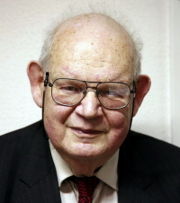伯努瓦·曼德勃羅
出自 MBA智库百科(https://wiki.mbalib.com/)
伯努瓦·曼德勃羅(Benoit Mandelbrot)——分形理論的創始人
目錄 |
曼德勃羅(Benoit B. Mandelbrot),數學家、經濟學家,分形理論的創始人。1924年生於波蘭華沙;1936年隨全家移居法國巴黎,在那裡經歷了動蕩的二戰時期;1948年在帕薩迪納獲得航空碩士學位;1952年在巴黎大學獲得數學博士學位;曾經是普林斯頓、日內瓦、巴黎的訪問教授,哈佛大學的“數學實踐講座”的教授,IBM公司的研究成員和會員。
Mandelbrot was born in Warsaw in a Jewish family from Lithuania. Anticipating the threat posed by Nazi Germany, the family fled from Poland to France in 1936 when he was 11. He remained in France through the war to near the end of his college studies. He was born into a family with a strong academic tradition—his mother was a medical doctor and he was introduced to mathematics by two uncles. His uncle, Szolem Mandelbrojt, was a Parisian mathematician. His father, however, made his living trading clothing. Mandelbrot attended the Lycée Rolin in Paris until the start of World War II, when his family moved to Tulle. He was helped by Rabbi David Feuerwerker, the Rabbi of Brive-la-Gaillarde, to continue his studies. In 1944 he returned to Paris. He studied at the Lycée du Parc in Lyon and in 1945-47 attended the école Polytechnique, where he studied under Gaston Julia and Paul Lévy. From 1947 to 1949 he studied at California Institute of Technology where he studied aeronautics. Back in France, he obtained a Ph.D. in Mathematical Sciences at the University of Paris in 1952.
From 1949 to 1957 Mandelbrot was a staff member at the Centre National de la Recherche Scientifique. During this time he spent a year at the Institute for Advanced Study in Princeton, New Jersey where he was sponsored by John von Neumann. In 1955 he married Aliette Kagan and moved to Geneva, Switzerland then Lille, France.
In 1958 the couple moved to the United States where Mandelbrot joined the research staff at the IBM Thomas J. Watson Research Center in Yorktown Heights, New York. He remained at IBM for thirty-two years, becoming an IBM Fellow, and later Fellow Emeritus.
From 1951 onward, Mandelbrot worked on problems and published papers not only in mathematics but in applied fields such as information theory, economics, and fluid dynamics. He became convinced that two key themes, fat tails and self-similar structure, ran through a multitude of problems encountered in those fields.
Mandelbrot found that price changes in financial markets did not follow a Gaussian distribution, but rather Lévy stable distributions having theoretically infinite variance. He found, for example, that cotton prices followed a Lévy stable distribution with parameter α equal to 1.7 rather than 2 as in a Gaussian distribution. "Stable" distributions have the property that the sum of many instances of a random variable follows the same distribution but with a larger scale parameter.
Mandelbrot also put his ideas to work in cosmology. He offered in 1974 a new explanation of Olbers' Paradox (the "dark night sky" riddle), demonstrating the consequences of fractal theory as a sufficient, but not necessary, resolution of the paradox. He postulated that if the stars in the universe were fractally distributed (for example, like Cantor dust), it would not be necessary to rely on the Big Bang theory to explain the paradox. His model would not rule out a Big Bang, but would allow for a dark sky even if the Big Bang had not occurred.
In 1975, Mandelbrot coined the term fractal to describe these structures, and published his ideas in Les objets fractals, forme, hasard et dimension (1975; an English translation Fractals: Form, Chance and Dimension was published in 1977). Mandelbrot developed here ideas from the article Deux types fondamentaux de distribution statistique (1938; an English translation Two Basic Types of Statistical Distribution) of Czech geographer, demographer and statistician Jaromír Korčák.
While on secondment as Visiting Professor of Mathematics at Harvard University in 1979, Mandelbrot began to study fractals called Julia sets that were invariant under certain transformations of the complex plane. Building on previous work by Gaston Julia and Pierre Fatou, Mandelbrot used a computer to plot images of the Julia sets of the formula z² − μ. While investigating how the topology of these Julia sets depended on the complex parameter μ he studied the Mandelbrot set fractal that is now named after him. (Note that the Mandelbrot set is now usually defined in terms of the formula z2 + c, so Mandelbrot's early plots in terms of the earlier parameter μ are left–right mirror images of more recent plots in terms of the parameter c.)
In 1982, Mandelbrot expanded and updated his ideas in The Fractal Geometry of Nature. This influential work brought fractals into the mainstream of professional and popular mathematics, as well as silencing critics, who had dismissed fractals as "program artifacts".
Upon his retirement from IBM in 1987, Mandelbrot joined the Yale Department of Mathematics. At the time of his retirement in 2005, he was Sterling Professor of Mathematical Sciences. His awards include the Wolf Prize for Physics in 1993, the Lewis Fry Richardson Prize of the European Geophysical Society in 2000, the Japan Prize in 2003, and the Einstein Lectureship of the American Mathematical Society in 2006. The small asteroid 27500 Mandelbrot was named in his honor. In November 1990, he was made a Knight in the French Legion of Honour. In December 2005, Mandelbrot was appointed to the position of Battelle Fellow at the Pacific Northwest National Laboratory.Mandelbrot was promoted to Officer of the French Legion of Honour in January 2006.
A partial list of awards received by Mandelbrot:
- 2004 Best Business Book of the Year Award
- AMS Einstein Lectureship
- Barnard Medal
- Caltech Service
- Casimir Frank Natural Sciences Award
- Charles Proteus Steinmetz Medal
- Franklin Medal
- Harvey Prize
- Honda Prize
- Humboldt Preis
- IBM Fellowship
- Japan Prize
- John Scott Award
- Lewis Fry Richardson Medal
- Medaglia della Presidenza della Repubblica Italiana
- Médaille de Vermeil de la Ville de Paris
- Nevada Prize
- Science for Art
- Sven Berggren-Priset
- Władysław Orlicz Prize
- Wolf Foundation Prize for Physics








